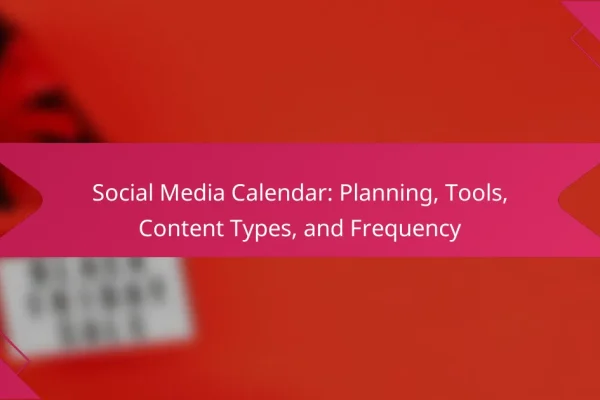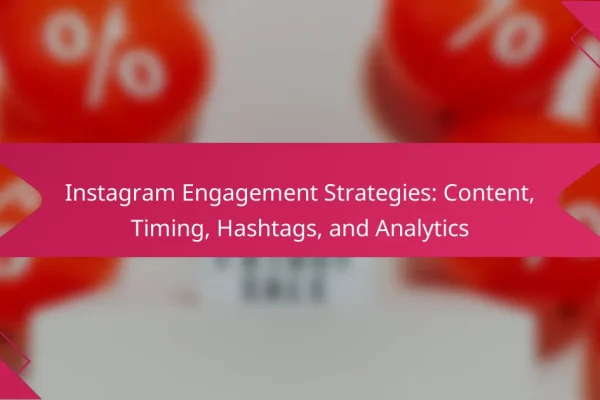What are effective social media marketing tactics in Canada?
Effective social media marketing tactics in Canada include a mix of content marketing, influencer collaborations, targeted advertising, live engagement events, and user-generated content. These strategies help brands connect with Canadian audiences by leveraging local trends and preferences.
Content marketing strategies
Content marketing strategies focus on creating valuable, relevant content to attract and engage a target audience. In Canada, this can include blog posts, videos, and infographics that resonate with local culture and interests. Brands should aim for consistency in posting and align their content with seasonal events or national holidays.
Consider using storytelling to make your content relatable. For example, sharing customer success stories or local community initiatives can enhance brand loyalty and engagement.
Influencer partnerships
Influencer partnerships involve collaborating with individuals who have a significant following on social media. In Canada, partnering with local influencers can help brands reach specific demographics effectively. Choose influencers whose values align with your brand to ensure authenticity in your campaigns.
When selecting influencers, consider their engagement rates and audience demographics. Micro-influencers, who typically have smaller but highly engaged followings, can often yield better results than larger influencers.
Targeted ad campaigns
Targeted ad campaigns allow brands to reach specific audience segments based on demographics, interests, and behaviors. In Canada, platforms like Facebook and Instagram offer robust targeting options that can help optimize ad spend. It’s crucial to define your target audience clearly to maximize the effectiveness of your campaigns.
Utilize A/B testing to refine your ads and improve performance. Monitor key metrics such as click-through rates and conversion rates to assess the success of your campaigns and make necessary adjustments.
Engagement through live events
Engagement through live events, such as webinars, Q&A sessions, or live streams, can foster real-time interaction with your audience. In Canada, hosting events that align with local interests or current trends can significantly boost engagement. Promote these events across your social media channels to maximize attendance.
Ensure to encourage participation by asking questions and responding to comments during the event. This two-way communication can enhance community building and brand loyalty.
User-generated content
User-generated content (UGC) involves encouraging your audience to create content related to your brand. This can include reviews, photos, or videos shared on social media. In Canada, UGC can be a powerful tool to build trust and authenticity, as potential customers often value peer recommendations over traditional advertising.
To incentivize UGC, consider running contests or campaigns that encourage users to share their experiences with your products. Highlighting this content on your brand’s social media channels can further engage your audience and create a sense of community.
How to choose the right social media platforms?
Selecting the right social media platforms involves understanding your target audience, their preferences, and the unique features of each platform. Focus on where your audience spends their time and how they engage with content to maximize your marketing efforts.
Audience demographics analysis
Analyzing audience demographics is crucial for choosing the right social media platforms. Look at age, gender, location, and interests to identify which platforms align with your target market. For instance, younger audiences may prefer TikTok or Instagram, while older demographics might be more active on Facebook.
Utilize tools like Google Analytics or social media insights to gather demographic data. This information helps tailor your content strategy and ensures you reach the right people effectively.
Platform engagement metrics
Engagement metrics provide insight into how users interact with content on different platforms. Key metrics include likes, shares, comments, and overall reach. High engagement rates often indicate a strong connection with the audience and can guide your platform selection.
Consider using analytics tools to track these metrics over time. Platforms like Instagram and Twitter may show higher engagement for visual content, while LinkedIn may be more effective for professional articles and B2B marketing.
Content type suitability
Different social media platforms cater to various content types, which influences your choice. For example, Instagram and Pinterest excel with visual content, while Twitter is ideal for short, concise messages. Understanding these preferences can enhance your content strategy.
Evaluate the types of content you plan to create—videos, images, articles, or infographics—and match them with the platforms that support them best. This alignment increases the likelihood of audience engagement and content sharing.
What are the best tools for social media marketing?
The best tools for social media marketing streamline processes, enhance engagement, and provide valuable insights. Popular options include Hootsuite for scheduling posts, Canva for creating graphics, and Buffer for analyzing performance metrics.
Hootsuite for scheduling
Hootsuite is a powerful tool for scheduling social media posts across multiple platforms. It allows users to plan content in advance, ensuring a consistent online presence without the need for daily manual posting.
When using Hootsuite, consider its user-friendly dashboard that lets you manage various accounts from one place. You can schedule posts for optimal times based on audience engagement patterns, which can significantly improve reach.
Canva for graphic design
Canva is an intuitive graphic design tool ideal for creating visually appealing social media content. It offers a wide range of templates tailored for different platforms, making it easy to produce professional-looking graphics quickly.
Utilize Canva’s drag-and-drop features to customize designs with your brand colors and fonts. This tool is particularly useful for marketers who may not have extensive design skills but want to create eye-catching visuals to enhance their posts.
Buffer for analytics
Buffer provides comprehensive analytics to track the performance of your social media efforts. It helps you understand which posts resonate most with your audience, allowing for data-driven adjustments to your strategy.
With Buffer, you can monitor engagement metrics such as likes, shares, and comments. Regularly reviewing these insights can guide your content creation and scheduling decisions, improving overall effectiveness in reaching your marketing goals.
What are the costs associated with social media marketing?
The costs associated with social media marketing can vary widely based on factors like platform choice, campaign scope, and content quality. Businesses should consider ad spend, tool subscriptions, and content creation costs when budgeting for their social media efforts.
Ad spend estimates
Ad spend is a significant component of social media marketing costs. Businesses typically allocate anywhere from a few hundred to several thousand dollars per month, depending on their goals and audience size. For example, small businesses might spend around $300 to $1,000 monthly, while larger companies could invest $10,000 or more.
It’s essential to monitor the return on investment (ROI) for ad spend. Platforms like Facebook and Instagram offer tools to track engagement and conversions, helping businesses adjust their budgets effectively.
Tool subscription fees
Many businesses use social media management tools to streamline their marketing efforts. Subscription fees for these tools can range from $10 to $300 per month, depending on the features and number of users. Popular tools include Hootsuite, Buffer, and Sprout Social.
When selecting a tool, consider the specific needs of your business, such as scheduling posts, analytics, and team collaboration. Some platforms offer free trials, allowing you to evaluate their effectiveness before committing financially.
Content creation costs
Creating high-quality content is crucial for successful social media marketing. Costs for content creation can vary widely, with expenses for graphic design, video production, and copywriting. Businesses might spend anywhere from $50 to $2,000 per piece of content, depending on complexity and quality.
To manage costs, consider leveraging user-generated content or repurposing existing materials. Additionally, setting a content calendar can help streamline production and ensure consistent posting without overspending.
How to measure social media marketing success?
Measuring social media marketing success involves tracking key performance indicators (KPIs) that reflect engagement, reach, and conversion. Common metrics include likes, shares, comments, and website traffic generated from social media platforms.
Key performance indicators (KPIs)
Key performance indicators (KPIs) are essential metrics that help assess the effectiveness of your social media marketing efforts. Common KPIs include engagement rate, follower growth, and conversion rate. Each of these metrics provides insights into how well your content resonates with your audience and drives desired actions.
For example, a high engagement rate indicates that your audience finds your content valuable, while follower growth shows your brand’s increasing reach. Conversion rate, on the other hand, measures how many social media users take a specific action, such as signing up for a newsletter or making a purchase.
Tools for tracking success
Various tools can help you track social media marketing success effectively. Platforms like Google Analytics, Hootsuite, and Sprout Social offer comprehensive analytics features that allow you to monitor KPIs in real time. These tools can provide detailed reports on user behavior, engagement, and traffic sources.
Using these tools, you can set up custom dashboards to visualize your data and identify trends over time. This can help you make informed decisions about your social media strategy and optimize your campaigns for better results.
Analyzing and interpreting data
Analyzing and interpreting data is crucial for understanding your social media marketing success. Look for patterns in your KPIs to determine what content performs best and what strategies need adjustment. For instance, if video posts consistently generate higher engagement than images, consider focusing more on video content.
Additionally, segment your audience data to gain insights into different demographics. This can help tailor your messaging and content to better meet the needs of specific groups, ultimately enhancing your overall marketing effectiveness.
Adjusting strategies based on insights
Adjusting your strategies based on insights gained from data analysis is vital for ongoing success. If certain posts or campaigns underperform, consider experimenting with different formats, posting times, or targeting options. Regularly reviewing your performance allows you to pivot quickly and capitalize on emerging trends.
For example, if you notice that posts made during weekends receive more engagement, you might adjust your posting schedule accordingly. Staying flexible and responsive to data-driven insights will help you maximize the impact of your social media marketing efforts.












